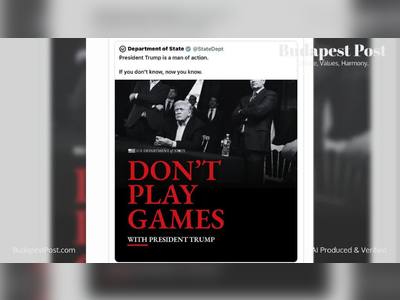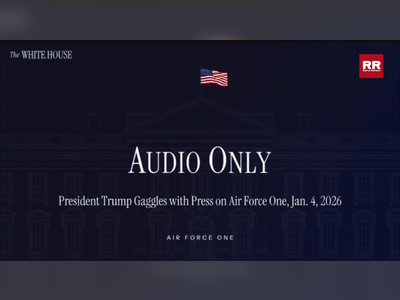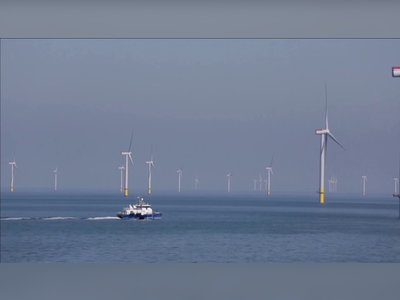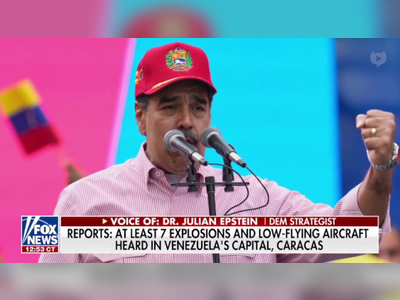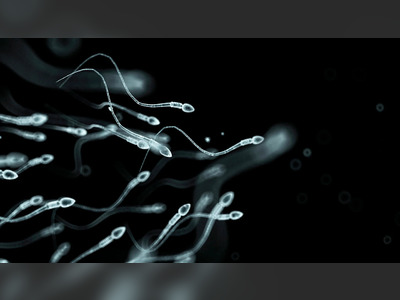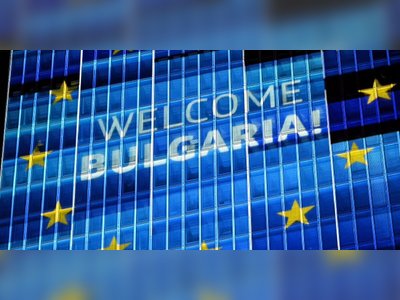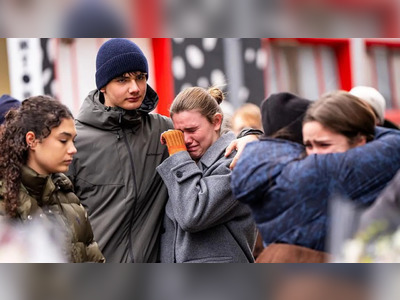
From Budapest to Belgrade: a railway line increases Chinese influence in the Balkans
The Chinese state is financing parts of a high-speed train route from Budapest, through Serbia and North Macedonia to the Greek port of Piraeus, which it owns. Investigate Europe’s reporters travelled the route and conducted research in all the countries that it runs through. Still under construction, this costly undertaking will take Hungary 979 years to pay off. Meanwhile, the European Union is wary of China’s expansionist policies in the region. Is the investment worth the trouble?
On 25 November 2015, a high-speed train was speeding at around 400 km/hr, travelling from Suzhou to Shanghai in China. Chinese Prime Minister Li Keqiang, Serbian President Aleksandar Vučić and Hungarian President Viktor Orbán sat at a table in one of the carriages. Judging by photos from the occasion, they were in a good mood. This was probably not unrelated to the fact that they had just signed an agreement on an important joint investment. Their countries would cooperate on the development of a high-speed railway between Belgrade and Budapest. Once completed, it would be the biggest rail project in the region.
What the leaders probably didn’t anticipate is that this new line wouldn’t even be half as fast as the train they were on right now. In fact, on the Hungarian side, the speed would be capped at 160km/hr.
In October, Investigate Europe’s journalists travelled from Budapest to Piraeus along this train route, which is still under construction. In Serbia, construction was initially scheduled to be done in 2018, but now both Serbian and Hungarian officials are promising that work will be completed in 2025.
This train route is used by freight trains loaded with Chinese goods travelling from the Chinese-owned Greek port of Piraeus towards central Europe. The Budapest-Belgrade project is part of the Belt and Road initiative — a cog in China’s broader expansion plan in Europe.
Between China and the EU
The Budapest-Belgrade railway line costs an awful lot, totalling around €3.8 billion. More than half the amount (around €2 billion) is estimated for the 160-km Hungarian section and €1.8 billion for 210 km on the Serbian side. The Hungarian government is financing 85% of the project with a Chinese state loan, but no further details are known because the loan agreement was classified for 10 years in 2020. The government defended its secrecy by stating that revealing the details would “jeopardise Hungary’s foreign policy”. However, a recent court ruling in the country has ruled that the government must disclose the details of the loan agreement.
For perspective, between 2004 and 2018, a total of €2.2 billion was spent on rail investments in the whole of the Western Balkans. The Chinese are spending almost twice as much on this single line, although only temporarily, as the Hungarian and Serbian taxpayers repaying the loan will ultimately foot the bill.
Meanwhile, south of Belgrade, the railway line is being upgraded with partial EU funding, meaning that Serbian President Vučić has cut the Chinese out of the project for the sake of the EU.
A win for China
For China, financing the Budapest-Belgrade line is most definitely a “win” situation. A significant part of the investment goes back to Chinese companies that have been contracted to build the line.
But this is secondary to the geopolitical gains that China stands to make in the region. “China is effectively paying off politicians and influential businessmen around the world with these projects,” said one Serbian consultant familiar with the situation. “It is a game of cat and mouse. Either you take the money or you don’t, but there are no strict conditions like, say, with the IMF or the EU,” said the adviser, who also has access to the Serbian government.
What about the passengers?
The largest tender for the Budapest-Belgrade line, worth nearly €1.6 billion, was won by RM International Zrt., a company owned by Lőrinc Mészáros (a childhood friend of Orbán’s who has rapidly become Hungary’s richest person in the recent past), China Tiejiuju Engineering & Construction Kft., and China Railway Electrification Engineering Group (Hungary) Kft. The Chinese subcontractors include virtually all those with which the US government has had run-ins in recent years, such as ZTE and Huawei.
Even if it wasn’t a priority until the Chinese came up with the idea, the Budapest-Belgrade railway line was due for a revamp. The 150-year-old single-track line was once used by the Orient Express, but today, few people take it from Budapest to the Serbian capital. Once completed, the fully electrified line will take three and a half hours to Belgrade, instead of the usual eight hours. But apart from the symbolic removal of some old rails, little progress has been made in Hungary, while a longer section in Serbia is already complete.
Some estimates have said that it would be far cheaper to upgrade the existing track to allow freight trains to run comfortably, and that some sections could be modified to allow faster passenger trains to overtake. Rail experts and our sources close to the Hungarian government readily agreed that freight traffic would be the key for this route.
Leaving Budapest’s Keleti station for Kelebia at dawn on a Monday, there were never more than 10 people on the express train at any given time. At Kelebia, the train didn’t go any further, and IE’s reporters had to cross the border by foot. Numbers dwindled even more after Kiskunlacháza, in central Hungary. It’s quite clear that passenger traffic on the Hungarian side is secondary and would not warrant a new track on its town.
In fact, one source confirmed that there was quite a strong lobby in Hungary for this train line to run along a different route that would have garnered more passenger traffic. But that would have been much more expensive because the line would have to cut through densely-populated areas.
But this lobby did not win.
“This lobby was put on hold because the agreement with the Chinese had already been reached, and the Chinese are not the type of actors who, once they have agreed something, want to change it,” a source close to the government said.
But if it’s all so expensive, will it at least be worth it in the long run? It doesn’t seem so.
Hungarian taxpayers lose out
Given that the Hungarian government has kept not just the loan agreement with the Chinese a secret, but also the feasibility study, it’s not immediately clear how the investment might pay off. One calculation put the payback period at 2,400 years, while another predicted 130 years. But concrete figures from the Serbian Ministry of Transport speak for themselves. They suggest that economic considerations did not play a key role in this project. The whole undertaking looks like Viktor Orbán’s political gesture to China.
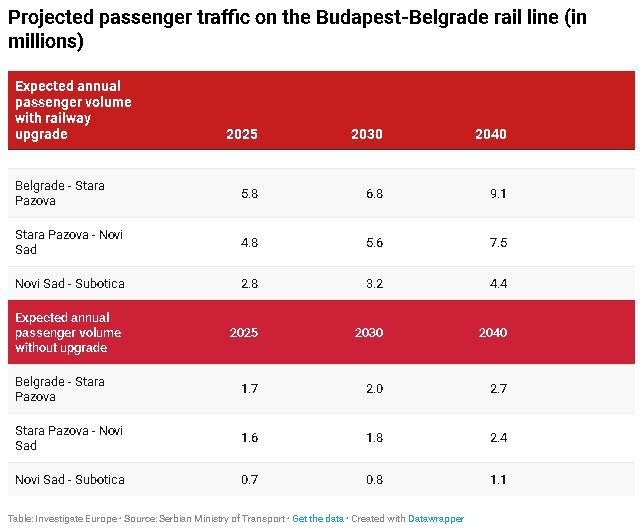
As the table shows, the rail upgrade is expected to increase passenger numbers. Supporters of the project predict that the growth in freight traffic will help pay for the project.
In this light, what is interesting from a Hungarian point of view is the expected increase in the volume of freight traffic from the Serbian city of Subotica to the border. By 2025, the Serbs have calculated an increase of 710 thousand tonnes, and by 2040, more than a million tonnes, thanks to the railway renovation.
In 2020, the EU imported €383 billion worth of goods from China, 58% of which came by sea, fitting into about 15 million containers. This huge amount arrived in many ports in Europe — a small proportion in Piraeus. Projections estimate that in 2025, there will be 33,000 extra containers coming through from Serbia and into the Hungarian village of Kelebia and onwards. These extra containers would require just one extra train a day. In 2025, if the same amount of Chinese goods were to arrive as last year, there would only be a 0.22% surplus in the volume of goods. Based on projections for 2040, the surplus would be 0.36%.
There isn’t much to be gained by way of tariffs either. According to the latest World Bank data, Hungary charges a 2.15% tariff on Chinese goods, four-fifths of which goes to the EU budget. This means that the Hungarian government stands to cash in €2.1 million as a result of the Budapest-Belgrade rail upgrade, through goods transported via rail from Piraeus to Hungary. If the project costs stay the same, it will pay for itself in 979 years.
Money well-spent in Serbia?
Meanwhile in Serbia, the section of the route between Novi Sad and Stara Pazova was officially opened in the presence of President Vučić in August.
At Stara Pazova, the rails on the tracks glistened on the white crushed stone as if they had just been taken out of the box. The station’s main building was freshly painted and the electrical equipment was all in place. This stretch is funded not just by the Chinese, but also the Russian government, which signed a loan agreement with Serbia in 2019.
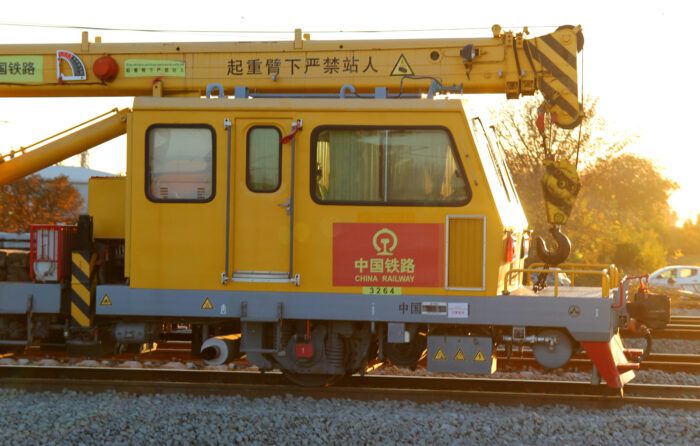 Construction at Stara Pazova, Serbia
Construction at Stara Pazova, Serbia
“The first priority is the construction of the high-speed railway line between Belgrade and Budapest, which has been a promise for years,” said Anita Dimoszki, Serbian deputy minister for railways. She admitted that there had been delays so far, but she said they were due to technical and administrative problems. Dimoszki also said that the project was good for Serbia not only because of the potential for freight traffic, but also because it would connect the country’s biggest cities after NATO bombed the rail network in 1999.
The 230-km journey from Belgrade to Niš on the Serbian section — still undergoing renovation — took IE’s reporters five and a half hours. Perhaps this was why there were only a handful of passengers on the relatively new train.
“Although progress is being made, we are still a long way from where we need to be,” Anita Dimoszki admitted to IE. “But the rail network is certainly something that is and should be the backbone of a country’s economy.” She added that the Budapest-Belgrade line would provide a modern railway upgrade for the inhabitants of the biggest cities, but she could not say anything about the economic return, directing us to the minister of finance, where we did not get an answer.
 Deputy minister Anita Dimoszki
Deputy minister Anita Dimoszki
The head of a Serbian consultancy organisation, who is also assisting the Serbian Government with this project, was very critical. At a background briefing in Belgrade, the consultant, who requested anonymity, said, “It’s definitely beneficial for Serbia, but the question is what would happen if this money was invested in the rest of the network to increase speed?
“Over the past ten years, the region has spent €2.2 billion on rail projects, while average speeds on the network have remained at 50 km/h. There has been no impact,” he added.
Funding from Russia and China is attractive, but challenged by the EU and the US
The Belgrade-Niš section of the route in Serbia will not be renovated with Chinese financing, but with EU money. As one European Commission official put it, ‘it is in the EU’s key interest to pursue its enlargement policy more effectively’, and in this, the construction of critical infrastructure is central to the Western Balkans.
“We got an incredible price,” said Serbian president Vučić in April 2021, when he agreed with the EU to finance the construction of the railway line south of Belgrade. It was then announced that it would cost a maximum of €1.2 billion euros, and that a third of it would be non-refundable EU money.
Perhaps this has something to do with increasing wariness towards China’s investment policies, perceived as being expansionist. In 2019, French President Emmanuel Macron said that the “era of European naivety” towards China was over. As Investigate Europe has previously written, Chinese investment in Europe is actually far less than US investment and yet, the EU is increasingly cautious.
China has a penchant for buying critical infrastructure, investing in ports from Antwerp to Valencia, Zeebrugge to Piraeus, and has interests in the Portuguese energy grid. And these investments give the country a more political role. The port acquisitions have already upset the US, with then-Secretary of State Mike Pompeo travelling to Athens in 2019 to add an amendment to the US-Greek defence pact to increase US presence in the port of Alexandroupoli.
That is why the EU also got involved in Serbia, protesting against Chinese involvement and only relenting until the European Commission declared the continuation of the Chinese-funded railway to northern Macedonia a priority project. Replies from the EC stressed that China was not being singled out, that if Chinese companies respect the rules and do not use state aid to distort competition, they can bid for EU contracts. The Serbian consultant who spoke to us anonymously also said that he believes that the EU is now “negotiating harder with those who choose Russian or Chinese loans and not their money.” He also clarified why non-EU money is tempting:
“The Chinese and Russians are offering 51% to domestic companies, which is a strong incentive for domestic industry. Of course, there is a tender, but it is an internal tender, so no German company will compete with them, and they will not take the work.”
North Macedonia remains a bottleneck
Inside a ministry building in Skopje, the capital of North Macedonia, there sits an EU flag. “We’ve wanted to be EU members for a long time,” laughed Transport Minister Blagoj Bocvarski. North Macedonia hasn’t even asked for Chinese money to upgrade its railways. If anything happens, it will be with EU funds. “Of course, the European Union is our strategic partner and we are focused on using as much money from there as possible,” the socialist minister said.
But North Macedonia is not excited about the construction of Corridor 10, the mainline on which the Budapest-Belgrade section lies. This corridor is not part of the official EU TEN-T regulation, which governs the main European routes, because it does not pass through member states, but it is an important route connecting Greece with the rest of Europe through central Europe.
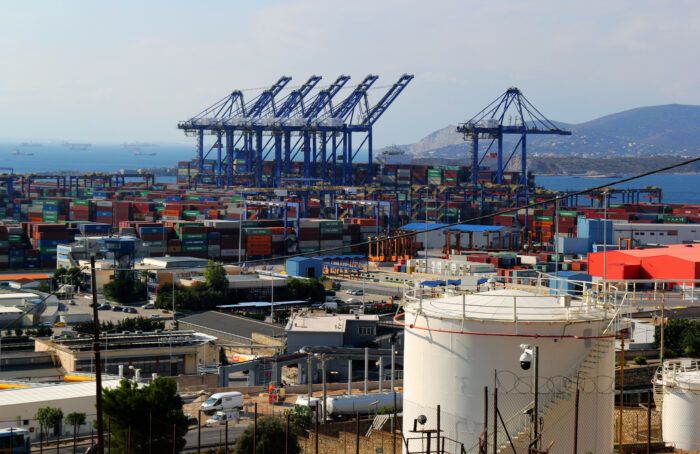 Piraeus port
Piraeus port
“If we talk about Corridor 10, [North Macedonia’s lines] are fully built, from the Serbian border to the Greek border, and it is electrified at 100 km/hr,” said Minister Bocvarski. But when Investigate Europe’s reporters took the train from Skopje to the Greek border in the Vardar valley, it didn’t seem so. The two-coach train didn’t speed at 100 km. This means that once the traffic from Piraeus really gets going, North Macedonia will be the bottleneck along the route.
Bocvarski explained that for North Macedonia, another train route — from Albania to the Bulgarian border — is more important, which is why it is being developed with EU money. Hungarian sources tell us that both Hungarians and Serbs are trying to persuade the Macedonians to develop Corridor 10, as promised by the former leader Gruevski, but the Macedonians have little interest in this and are not inclined to do so.
How much does this matter in Piraeus?
Today, the best way to get to Greece from the North Macedonian border is actually not by train, but by taxi. Freight trains cross the border, but there is little demand for passenger coaches.
Once in Greece, the train to Athens glides along at a surreal speed compared to the experience of the past few days. The rails end in Piraeus: here is the port that the Chinese acquired in the late 2000s, establishing a foothold in the Balkans. During the euro crisis, the austerity policies imposed on the Greeks forced the government to sell the country’s most important strategic port to the Chinese.
The Piraeus port is owned by the Chinese State Ocean Shipping Corporation (COSCO), the world’s largest shipping company. COSCO acquired a majority stake in the port in 2009 and has now increased its ownership to 67%, and also has a hand in the supervision of the port. COSCO’s investment of €600 million over 10 years is already having an impact, Piraeus has gone from a small port to the largest port in the Mediterranean, ranked fourth in Europe last year in terms of the number of containers handled. The “big three” of the north (the ports of Antwerp, Rotterdam and Hamburg) are still far ahead of Piraeus, but the Chinese are catching up. The mayors of Piraeus and neighbouring municipalities say that while there is technically room for expansion, they oppose it. And although the goods coming in at the port are the motivation for the whole railway construction, it would actually not be a huge problem for the Chinese if the railway is not built.
The port itself says it can handle only 10 trains a day, but that could change in the future. Meanwhile, a significant proportion of containers are already transported by small vessels from Piraeus to the ports of Copernicus and Trieste. This transhipment is necessary because large cargo carriers cannot enter the Adriatic.
Rail transport through the Balkans is also hampered by bad train lines, but it is the long hours spent at the borders that make freight transport on Corridor 10 really uncompetitive. According to one survey, it takes, on average, four days to move goods from Piraeus to Budapest, and more than a day of that time is spent at the border.
Versions of this story have been published by our media partners Danas in Serbia and Telex in Hungary. The Hungarian reporting won the Főszerkesztők Fóruma Award for Quality Journalism in November 2021.
